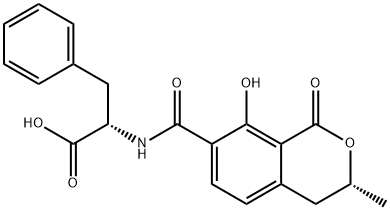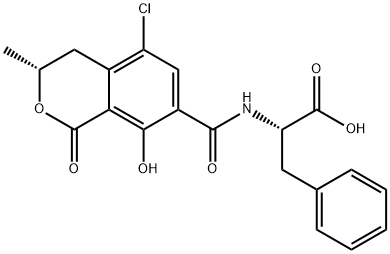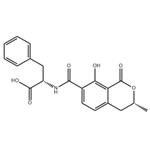Description
Ochratoxins are mycotoxins produced by
Aspergillus and
Penicillium species of fungi that contaminate foods. Ochratoxin A (OTA, ) is a chlorinated form with toxicity that targets the kidneys, causing nephropathy and renal adenomas. OTB is a non-
chlorinated analog of OTA that has cytotoxic effects on kidney and liver cells
in vitro but only minor effects
in vivo, due to its rapid metabolism and excretion. OTB inhibits cell proliferation of human liver HepG2 cells at doses as low as 1 μg/ml but lacks the genotoxic activity of OTA, even at higher concentrations.
Uses
Ochratoxin B is the non-chlorinated analogue of the much more extensively studied ochratoxin A. It is co-produced by the same species of Aspergillus and Penicillium that are associated with food spoilage. Ochratoxin B has received little focused investigation and its mode of action and potential hazards have been inferred from ochratoxin A.
Uses
Ochratoxins are toxic metabolites from Aspergillus orchraceus.
Definition
ChEBI: Ochratoxin B is a phenylalanine derivative resulting from the formal condensation of the amino group of L-phenylalanine with the carboxy group of (3R)-8-hydroxy-3-methyl-1-oxo-3,4-dihydro-1H-2-benzopyran-7-carboxylic acid. Ochratoxin B differs from the more naturally abundant ochratoxin A in the absence of the dihydroisocoumarin chlorine atom. It has cytotoxic effects on kidney and liver cells in vitro but only minor effects in vivo, due to its rapid metabolism and excretion. It inhibits cell proliferation of human liver HepG2 cells at doses as low as 1 mug/ ml but lacks the genotoxic activity of ochratoxin A, even at higher concentrations. It has a role as an Aspergillus metabolite, a Penicillium metabolite, a mycotoxin and a calcium channel blocker. It is a phenylalanine derivative, a N-acyl-L-phenylalanine, a member of isochromanes and a monocarboxylic acid. It is a conjugate acid of an ochratoxin B(1-).
General Description
Crystals that exhibit blue fluorescence.
Reactivity Profile
OCHRATOXIN B is incompatible with strong oxidizing agents, strong acids and strong bases. OCHRATOXIN B is a carboxylic acid derivative. Carboxylic acids donate hydrogen ions if a base is present to accept them. They react in this way with all bases, both organic (for example, the amines) and inorganic. Their reactions with bases, called "neutralizations", are accompanied by the evolution of substantial amounts of heat. Neutralization between an acid and a base produces water plus a salt.
Fire Hazard
Flash point data for OCHRATOXIN B are not available. OCHRATOXIN B is probably combustible.






